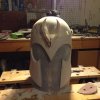Hello RPF. This is my first attempt molding/casting so I'm having some trouble estimating how much materials the process will take.
I'm nearing completion on my first ever piece, a First Class Shaw/Magneto helmet. Here's a picture for reference:

It's about 13" x 8" x 9" if you were to measure it as a cube.
I still need to add the trim and finish the forehead crest (but I'm less worried about that since its going to be a different mold alltogether), but I plan on being done by this weekend so I can make my mold and start making casts. I went on amazon earlier in the week and bought this and this, as well as some mold release. I didn't really look at how much I was buying, but it came in the mail last night and I'm a little worried that I'm not going to have enough. I'm more worried about the amount of silicone since I can always get more plastic later, but I really don't want to get half way through the mold and find out that I don't have enough to finish (because I assume this will ruin the mold?).
Do you guys think that I'll have enough? One thing that crossed my mind was maybe using something else other than silicone to make the registration keys just to save on materials. I saw a video on youtube of a guy using thin slices of dowels, and I don't see why this wouldn't work. Does anyone have any thoughts on that. About how many helmets at a reasonable thickness do you think I can get from that amount of liquid plastic?
Also, did I get the right materials? I know there was several kinds of silicone available, but I didn't seem to find a definitive answer on which was best for helmets. If dragon skin isn't going to work, I can always buy something else and save this for another situation. Maybe the forehead crest?
I'm nearing completion on my first ever piece, a First Class Shaw/Magneto helmet. Here's a picture for reference:

It's about 13" x 8" x 9" if you were to measure it as a cube.
I still need to add the trim and finish the forehead crest (but I'm less worried about that since its going to be a different mold alltogether), but I plan on being done by this weekend so I can make my mold and start making casts. I went on amazon earlier in the week and bought this and this, as well as some mold release. I didn't really look at how much I was buying, but it came in the mail last night and I'm a little worried that I'm not going to have enough. I'm more worried about the amount of silicone since I can always get more plastic later, but I really don't want to get half way through the mold and find out that I don't have enough to finish (because I assume this will ruin the mold?).
Do you guys think that I'll have enough? One thing that crossed my mind was maybe using something else other than silicone to make the registration keys just to save on materials. I saw a video on youtube of a guy using thin slices of dowels, and I don't see why this wouldn't work. Does anyone have any thoughts on that. About how many helmets at a reasonable thickness do you think I can get from that amount of liquid plastic?
Also, did I get the right materials? I know there was several kinds of silicone available, but I didn't seem to find a definitive answer on which was best for helmets. If dragon skin isn't going to work, I can always buy something else and save this for another situation. Maybe the forehead crest?
Last edited:
